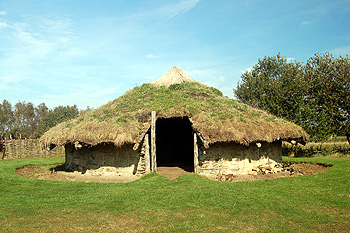Tebworth Before 1086

A reconstruction of an Bronze Age round house at Flag Fen October 2011
The Bedfordshire Historic Environment Record [HER] contains information on the county’s historic buildings and landscapes and summaries of each entry can now be found online as part of the Heritage Gateway website. Parts of Tebworth were occupied at various times during the vast span of years making up prehistory. Field walking south-west of Tebworth has produced some Mesolithic flint flakes [HER 16261]. Flint tools from the Neolithic or Bronze Age were found west of Tebworth and north of Trinity Farm through field walking [HER 16265]. It is a common misconception that with the beginning of the Bronze Age flint was no longer used. In fact it was in use for tools throughout the Bronze Age and into the Iron Age because there was a plentiful supply close at hand and the process of making flint tools was much quicker and easier, in skilled hands, than casting something in copper, bronze or iron.
A copper-alloy palstave axe from the middle Bronze Age was discovered east of College Farm in 2011 [HER 19330]. Also possibly Bronze Age were hut circles once visible on Steps Hill and recorded by J. G. Gurney in the first part of the 20th century [HER 11995]. If not Bronze Age the circles were likely Iron Age in date.
A ring [HER 19319], possibly Roman, was found in 2011 by a metal detectorist east of College Farm. The Romans invaded Britain in 43AD and remained until 410. Pieces of Romano-British pottery have been found by field walking south of Tebworth [HER 16266]. An unidentified copper alloy object found in 2011 by a metal detectorist south of Hill Farm may be Roman in date [HER 19307]. A brass sestertius, the largest and highest value base metal coin, of the Emperor Antoninus Pius [138-161 AD] was found by a metal detectorist in 2011 near Hill Cottage. In 1904 a fragment of a millstone grit whetstone was found in Tebworth [HER 1436].
The Dark Ages is that period beginning with the final withdrawal of Rome from Britain in 410 AD. It may be argued that this period, when the glories of the Classical World of Greece and Rome were forgotten and replaced by an intellectual recession and triumph of barbarism over civilization, stretched as far as the Renaissance when Classical learning was rediscovered. Traditionally, in England, it was held to end with the Norman Conquest of 1066. Such a view is, nowadays, unfashionable, and the term Early Medieval is generally preferred, but Dark Ages still has a popular resonance! In 2011 a metal detectorist found two Anglo-Saxon coins, part of a knife scabbard and a stirrup south of Hill Farm [HER 19306].